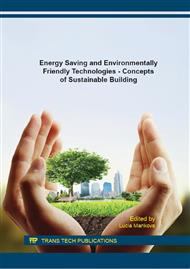p.740
p.751
p.761
p.770
p.779
p.786
p.795
p.803
p.811
Cool Roofs vs Solar Systems
Abstract:
Well known problem of urban heat island is partly due to the albedo of traditional roofs. Mostexperts of urban climate are convinced that the intensity of urban heat island will be less if theroofs reflect as big part of the solar radiation as possible. Researchers have found or developedappropriate materials of low absorptance in the wavelength spectrum of solar radiation together with high emissivity in the long infrared interval. As a result, roof covering may have such extraparameters as metal roof painted with colored cool coating has 0.8 reflectance and 0.8 emittanceindex or single ply-membrane white (PVC) has 0.7 reflectance and 0.8 emittance index.No doubt taking into account the settlement as a whole cool roofs may decrease the intensity ofurban heat island however some local negative effect should not be forgotten. Approaching the citycenter it is typical that low rise and tall buildings are nearby. In some cases the same buildinghas high and low rise wings, from the point of view of geometry similar is the situation between thefacade and a canopy or a balcony. In this case the radiation reflect by the horizontal surfaceconsiderably increases the load on the facade, in this paper the relevant cases are analysed and thecalculated extra load and its consequences are evaluated.
Info:
Periodical:
Pages:
779-785
Citation:
Online since:
January 2016
Authors:
Price:
Сopyright:
© 2016 Trans Tech Publications Ltd. All Rights Reserved
Share:
Citation:


